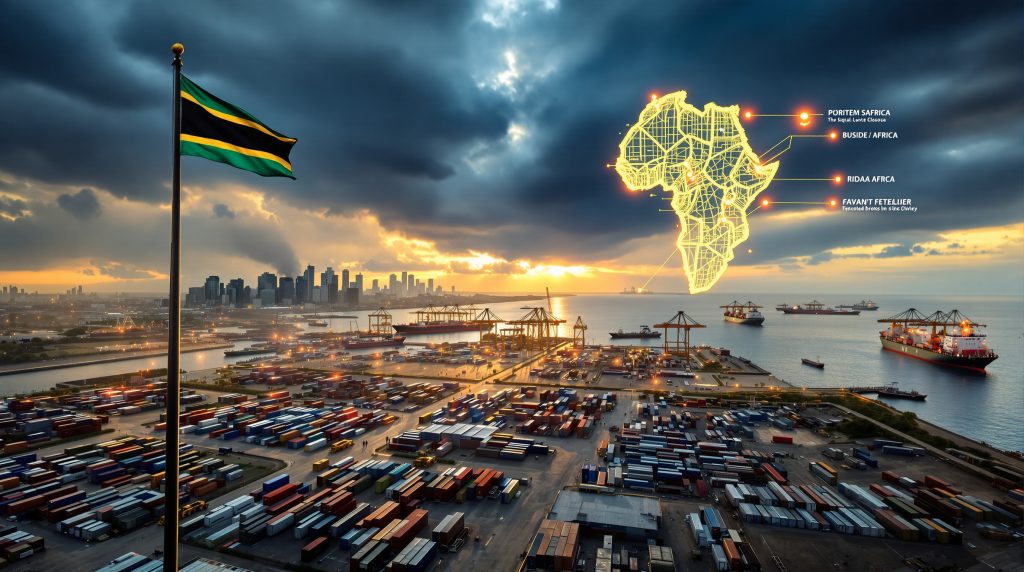Civil Unrest Forces Critical East African Trade Gateway to Suspend Operations
Tanzania's most vital commercial port ceased all operations following widespread civil disturbances that erupted after the country's general elections on October 29, 2025. The Dar es Salaam port closure has created immediate disruptions across East African supply chains, affecting multiple commodity sectors and regional trade networks.
According to fertilizer storage and logistics company C Steinweg, which operates facilities at the port, operations remained completely suspended through October 31, 2025. The company confirmed that no personnel were present on-site and that all cargo movements had been halted entirely.
The port closure coincided with peak fertilizer import season, creating particularly severe disruptions for agricultural supply chains. Sulphur imports had reached approximately 1 million tonnes by October 2025, representing a nearly 50% increase compared to the previous year, according to market analysis from Argus Media published on October 30, 2025.
Political Instability Triggers Comprehensive Security Response
The shutdown stemmed directly from nationwide unrest following Tanzania's general elections. Post-election tensions escalated rapidly, forcing authorities to implement emergency protocols across the country's economic capital and beyond.
Timeline of Critical Events:
- October 29, 2025: General elections conducted nationwide
- October 30, 2025: Civil disturbances begin in major urban centers
- Midnight October 30: Port operations officially suspended
- October 31, 2025: Closure extended with indefinite timeline
Government officials responded with comprehensive emergency measures designed to restore order and protect critical infrastructure. These included nationwide internet blackouts to limit coordination among protesters, strict curfews implemented across the Dar es Salaam metropolitan area, and enhanced security presence at key facilities.
Public sector employees received instructions to work remotely for safety reasons, while authorities deployed additional police resources to secure vital economic assets including the port complex itself.
Massive Commodity Stockpiles Accumulate During Closure
The timing proved particularly problematic for regional fertilizer markets, as the closure occurred during the critical import season for agricultural inputs. Furthermore, market estimates suggested that 250,000 to 300,000 tonnes of sulphur had accumulated in port warehouses as shipments decelerated throughout October.
This substantial inventory buildup reflected the broader challenges facing East African agricultural supply chains, which depend heavily on imported fertilizer materials during specific seasonal windows. The accumulated stockpile represented a significant portion of the region's sulphur requirements, creating potential price pressures and distribution challenges.
Immediate Operational Impact:
- Complete suspension of all vessel movements
- Zero cargo handling capacity across all terminals
- Indefinite delays for shipments already in transit
- Accumulation of time-sensitive agricultural inputs
The closure affected multiple commodity categories beyond fertilizers, including petroleum products essential for domestic consumption and regional distribution to landlocked neighbouring countries. In addition, mining equipment and supplies destined for operations across the region also faced indefinite delays, despite South Africa beneficiation efforts continuing elsewhere.
Strategic Importance of East Africa's Busiest Port
Dar es Salaam serves as the primary maritime gateway for multiple landlocked nations, making its operational status crucial for regional economic stability. The facility handles the majority of Tanzania's international trade while serving as a critical transit hub for neighbouring countries.
The port's geographic position provides essential access to global markets for countries including Rwanda, Burundi, and eastern regions of the Democratic Republic of Congo. However, secondary markets served by the facility include portions of Uganda, Zambia, and Malawi, making the closure's impact extend far beyond Tanzania's borders.
Regional Service Network:
- Primary markets: Direct service to landlocked East African nations
- Secondary markets: Alternative routing for multiple countries
- Transit function: Critical link between interior regions and global trade
- Economic significance: Major foreign exchange generator for Tanzania
The facility's capacity and efficiency have grown substantially in recent years, positioning it as an increasingly important component of East African trade infrastructure. This growth trajectory made the sudden closure particularly disruptive for established supply chain patterns.
Fertilizer Industry Faces Peak Season Disruption
The agricultural sector experienced the most immediate impact from the closure, as the timing coincided with critical fertilizer import periods. Sulphur, a key component in fertilizer production, represented one of the most affected commodities.
Market analysis indicated that sulphur imports had increased dramatically throughout 2025, with cumulative October volumes reaching unprecedented levels. The nearly 50% year-over-year increase in imports reflected growing regional demand for agricultural inputs.
Fertilizer Sector Disruptions:
- Import volume surge: Dramatic increase in sulphur shipments
- Seasonal timing: Closure during peak agricultural input season
- Inventory buildup: Massive stockpiles trapped at port facilities
- Regional distribution: Delayed supplies for multiple East African markets
C Steinweg's confirmation that facilities would remain closed through the end of October directly affected fertilizer storage and logistics operations. The company's statement, as reported by Argus Media on October 30, 2025, emphasised the complete halt to cargo movement both into and out of the port complex.
This disruption created cascading effects throughout regional agricultural supply chains, potentially affecting planting seasons and crop production planning across multiple countries that depend on imported fertilizer materials.
Energy Sector Experiences Supply Chain Pressure
Petroleum product imports faced immediate disruption, creating potential shortages for both domestic consumption and regional distribution networks. The port typically serves as a critical entry point for fuel supplies destined for landlocked countries throughout the region.
Energy security concerns emerged as the closure extended, particularly given the facility's role in regional fuel distribution patterns. Countries without direct maritime access depend heavily on overland transportation networks that originate from Dar es Salaam's petroleum terminals.
Energy Supply Implications:
- Delayed petroleum imports for domestic market consumption
- Disrupted fuel distribution to landlocked regional markets
- Increased pressure on alternative supply routes through other countries
- Potential price volatility in regional energy markets
Alternative routing through facilities in Kenya and South Africa became necessary but created additional logistical complications and increased transportation costs for energy supplies. Moreover, the oil market dynamics add complexity to pricing predictions during such disruptions.
Alternative Port Options Present Capacity Constraints
Regional shipping networks maintain contingency plans utilising alternative maritime gateways, though each option presents distinct challenges and limitations. The diversion of cargo typically handled through Dar es Salaam creates capacity pressure at other regional facilities.
Primary Alternative Routes:
| Alternative Port | Distance Impact | Capacity Considerations | Transit Time Changes |
|---|---|---|---|
| Mombasa, Kenya | 450 kilometres north | Higher capacity available | Additional 2-3 days |
| Durban, South Africa | 2,100 kilometres south | Substantial capacity | Additional 7-10 days |
| Beira, Mozambique | 1,200 kilometres south | Limited capacity | Additional 5-7 days |
Each alternative presents unique advantages and limitations. Mombasa offers relatively closer proximity but requires coordination with Kenyan authorities and transportation networks. Durban provides substantial capacity but involves significantly longer transit times and higher costs.
Overland transportation alternatives create additional complexity through varying infrastructure quality, border crossing procedures, and security considerations along different routes. Capacity constraints at alternative facilities limit their ability to absorb the full volume typically processed through Dar es Salaam.
Historical Context of Port Disruptions in East Africa
Political events represent one of several factors that can temporarily close major port facilities across the region. Understanding these patterns helps contextualise the current situation and potential recovery scenarios.
Common Disruption Categories:
- Political instability: Civil disturbances and election-related tensions
- Labour disputes: Work stoppages and strike actions
- Natural disasters: Extreme weather events and environmental challenges
- Security concerns: Terrorism threats and military conflicts
Previous port closures in East Africa provide insights into typical recovery patterns and economic impact duration. Recovery timelines typically depend on security stabilisation, infrastructure damage assessment, and workforce availability.
International shipping companies and commodity traders maintain risk mitigation strategies including diversified routing options, strategic inventory positioning, and specialised insurance coverage for political risk scenarios. Seatrade Maritime reported similar concerns regarding operational continuity during the closure.
Economic Consequences Extend Beyond Immediate Trade
Port disruptions create cascading effects throughout regional economies, particularly affecting import-dependent nations and time-sensitive commodity flows. The immediate impact includes supply chain bottlenecks, increased logistics costs, and potential currency pressure from reduced foreign exchange earnings.
Short-term Economic Effects:
- Supply bottlenecks: Delayed delivery of essential goods and materials
- Cost increases: Alternative routing through more expensive transportation channels
- Currency impact: Reduced foreign exchange from port service revenues
- Employment disruption: Temporary unemployment for port workers and related services
Recovery patterns from previous regional port closures suggest that immediate restart typically occurs within 24-48 hours after security stabilisation. Full operational capacity restoration generally requires 7-14 days depending on cargo backlog accumulation.
However, complete supply chain normalisation usually takes 2-4 weeks as alternative routing arrangements wind down and normal trading patterns resume. These timelines can vary significantly based on the severity and duration of the underlying political situation, particularly when considering tariff market impact on regional trade patterns.
Risk Management Strategies for Regional Trade
The current closure highlights the importance of diversified supply chain strategies and robust risk management approaches for companies operating in East African markets. Industry participants employ various methods to mitigate port closure risks.
Risk Mitigation Approaches:
- Routing diversification: Multiple port options for critical supply chains
- Strategic inventory: Stockpiling at key distribution locations
- Insurance coverage: Specialised policies for political risk and business interruption
- Monitoring systems: Real-time tracking for early warning capabilities
Regional cooperation and integrated infrastructure planning become increasingly important for maintaining trade continuity during political disruptions. Shared protocols and mutual assistance agreements can help minimise the impact of individual facility closures.
Long-term Infrastructure Development Implications
The closure underscores the vulnerability of critical infrastructure to political instability and highlights opportunities for enhanced regional integration. Strategic development priorities include improving operational resilience and expanding alternative capacity options.
Strategic Development Areas:
- Facility modernisation: Upgrading existing ports for improved efficiency and security
- Alternative development: Expanding capacity at secondary gateway facilities
- Transportation improvement: Better road and rail connections between ports and interior markets
- Governance strengthening: Enhanced political stability and conflict resolution mechanisms
Regional integration offers significant benefits through coordinated infrastructure development, standardised emergency procedures, and improved information sharing systems. Capacity sharing agreements and mutual assistance protocols can provide backup options during individual facility disruptions, especially as industry innovation trends reshape supply chain management.
Recovery Timeline and Market Normalisation Expectations
Port reopening procedures typically follow established security and operational protocols once political situations stabilise. The speed of recovery depends on multiple factors including infrastructure damage, workforce availability, and cargo backlog management.
Recovery Process Stages:
- Security clearance: Authorities assess and approve facility safety
- Workforce return: Personnel resume operations under normal conditions
- System restart: Equipment testing and operational capability verification
- Backlog processing: Accumulated cargo handling and vessel scheduling
Market participants closely monitor government communications and security assessments to anticipate reopening timelines. Ships already en route typically receive diversion instructions to alternative facilities or remain at anchor awaiting clearance.
Insurance coverage for political risk scenarios may provide compensation for business interruption, cargo delays, and additional transportation costs resulting from the closure. However, coverage terms vary significantly based on specific policy provisions and political risk classifications.
What Factors Determine Recovery Speed?
Recovery speed depends primarily on political stabilisation and security restoration. Furthermore, infrastructure integrity assessment plays a crucial role, as authorities must verify that facilities remain operational and safe.
Workforce availability represents another critical factor, as employees must feel secure enough to return to normal duties. Finally, cargo backlog management determines how quickly normal operations can resume once the port reopens.
Regional Trade Integration and Cooperation Benefits
The current disruption demonstrates the value of enhanced regional cooperation and coordinated emergency response capabilities. Shared infrastructure planning and standardised procedures can improve resilience against individual facility closures.
Regional Cooperation Advantages:
- Infrastructure coordination: Joint development of transportation networks
- Emergency protocols: Standardised procedures for crisis management
- Information sharing: Real-time communication systems between facilities
- Capacity sharing: Mutual assistance agreements during disruptions
East African Community initiatives and regional economic integration efforts provide frameworks for addressing infrastructure vulnerabilities and improving trade continuity. These multilateral approaches can help minimise the impact of individual country political situations on regional commerce.
The broader global trade impact of such disruptions extends beyond immediate regional effects, influencing international supply chains and commodity markets worldwide.
Critical Analysis: The Dar es Salaam port closure represents a significant disruption to East African trade networks, highlighting the interconnected nature of regional commerce and the vulnerability of critical infrastructure to political instability. The timing during peak fertilizer import season particularly compounds the economic impact across multiple countries.
Key Recovery Factors:
- Political stabilisation and security restoration
- Coordination with alternative port facilities
- Effective cargo backlog management
- Regional cooperation in emergency response
The situation underscores the strategic importance of diversified supply chains and robust risk management strategies for companies operating in politically sensitive regions. Long-term infrastructure development and regional integration initiatives may help reduce vulnerability to similar disruptions in the future.
Note: This analysis is based on breaking news from October 30, 2025, and market data from Argus Media. Political situations remain fluid, and recovery timelines may vary based on ongoing developments.
How Can You Position Yourself for Market Opportunities Emerging from Supply Chain Disruptions?
Discovery Alert's proprietary Discovery IQ model delivers real-time alerts on significant mineral discoveries across the ASX, helping subscribers identify actionable trading opportunities that emerge during market volatility and supply chain disruptions like the Dar es Salaam port closure. Discover how major mineral discoveries can generate substantial market returns by exploring Discovery Alert's dedicated discoveries page, showcasing historic examples of exceptional investment outcomes.




